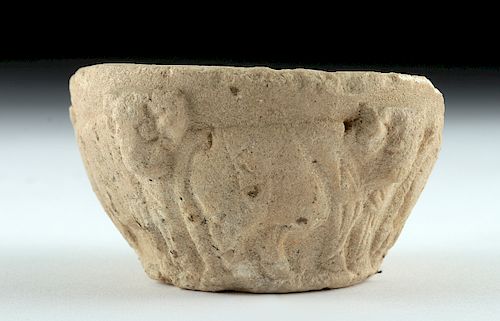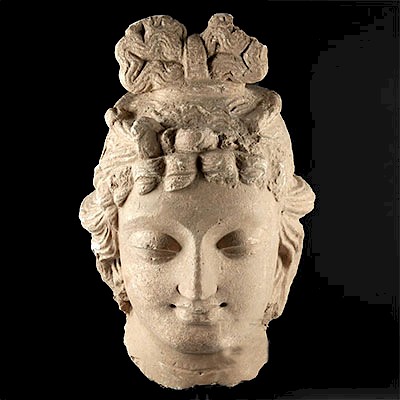Mesopotamian Stone Carved Bowl with Bulls
Lot 86a
About Seller
Artemis Fine Arts
686 S Taylor Ave, Ste 106
Louisville, CO 80027
United States
Selling antiquities, ancient and ethnographic art online since 1993, Artemis Gallery specializes in Classical Antiquities (Egyptian, Greek, Roman, Near Eastern), Asian, Pre-Columbian, African / Tribal / Oceanographic art. Our extensive inventory includes pottery, stone, metal, wood, glass and textil...Read more
Estimate:
$1,500 - $2,000
Absentee vs Live bid
Two ways to bid:
- Leave a max absentee bid and the platform will bid on your behalf up to your maximum bid during the live auction.
- Bid live during the auction and your bids will be submitted real-time to the auctioneer.
Bid Increments
| Price | Bid Increment |
|---|---|
| $0 | $25 |
| $300 | $50 |
| $1,000 | $100 |
| $2,000 | $250 |
| $5,000 | $500 |
| $10,000 | $1,000 |
| $20,000 | $2,500 |
| $50,000 | $5,000 |
| $100,000 | $10,000 |
| $200,000 | $20,000 |
About Auction
By Artemis Fine Arts
Aug 30, 2018
Set Reminder
2018-08-30 10:00:00
2018-08-30 10:00:00
America/New_York
Bidsquare
Bidsquare : Fine Antiquities / Asian / Ethnographic Art
https://www.bidsquare.com/auctions/artemis-gallery/fine-antiquities-asian-ethnographic-art-3402
Featuring classical antiquities, Asian, ancient and ethnographic art from cultures encompassing the globe, plus fine art. Artemis Fine Arts info@artemisgallery.com
Featuring classical antiquities, Asian, ancient and ethnographic art from cultures encompassing the globe, plus fine art. Artemis Fine Arts info@artemisgallery.com
- Lot Description
Southern Mesopotamia, possibly Sumerian, Late Uruk to Jemdet Nasr, ca. 3300 to 2900 BCE. Carved from a single piece of creamy white stone, a petite bowl with a procession of four bulls moving toward the right delineated in relief - each one standing in profile with outward facing heads, wonderfully contoured muscular bodies, and long, twisted tails. The bull was a symbol of virility and fertility. What's more, the Sumerians also combined human and bull features in their visual culture. For example, among the most beloved treasures from the Royal Tombs of Ur is the Great Lyre (University of Pennsylvania Museum of Archaeology and Anthropology) which depicts a nude bearded male figure holding two human-headed bulls, as well as the famous lamassu - human-headed winged bulls - of the earlier Neo-Assyrian period which were believed to be protective deities. Size: 3.125" in diameter x 1.625" H (7.9 cm x 4.1 cm)
A fragment of a similar frieze of bulls in relief from a Mesopotamian steatite bowl is in the collection of the Metropolitan Museum of Art. The description reads in part, "Vessels of this type have been frequently found in palaces or religious structures, which suggests that they had a special function in such settings. After cylinder seals, they are the most important source of pictorial information for the period. The pictures are drawn from the natural realm, often portraying, as here, an ordered world of domesticated animals or, alternatively, the threat of potentially hostile creatures such as the lion." (https://www.metmuseum.org/toah/works-of-art/50.218/)
Provenance: private East Coast, USA collection
All items legal to buy/sell under U.S. Statute covering cultural patrimony Code 2600, CHAPTER 14, and are guaranteed to be as described or your money back.
A Certificate of Authenticity will accompany all winning bids.
We ship worldwide and handle all shipping in-house for your convenience.
#135275Losses to upper section/rim including top of one bull's head as shown, but the vessel form is relatively well preserved, with all four bulls visible. Black deposits on interior.Condition
- Shipping Info
-
All shipping is handled in-house for your convenience. Your invoice from Artemis Gallery will include shipping calculation instructions. If in doubt, please inquire BEFORE bidding for estimated shipping costs for individual items.
-
- Buyer's Premium



 EUR
EUR CAD
CAD AUD
AUD GBP
GBP MXN
MXN HKD
HKD CNY
CNY MYR
MYR SEK
SEK SGD
SGD CHF
CHF THB
THB
















